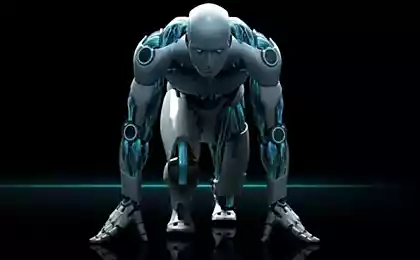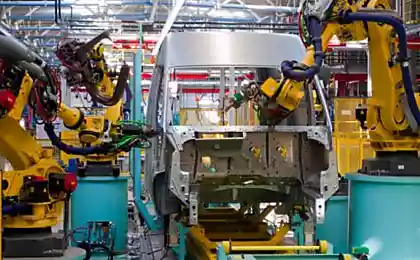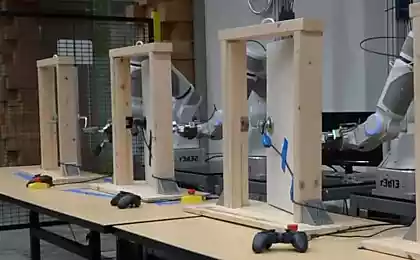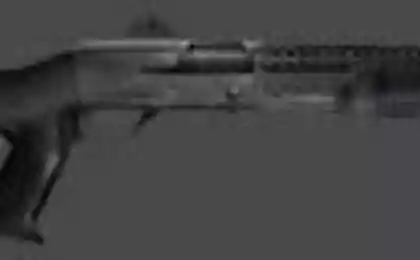595
Automatons: a 200 year old robots
It is difficult to surprise someone with a robot. They are already among us — working in factories, saving people in emergency situations, disarm bombs, drive cars. Sometimes satisfy other human needs.
But as it looked a couple hundred years ago? Or four hundred years? Yes, there was also some similarity robots, a mechanical device resembling a human or animal. They played musical instruments, wrote with a pen, danced, growled, and made other actions capable of shocking the common man. Today we are talking about mechanical monks, egg-laying ducks and programmable writing boys.
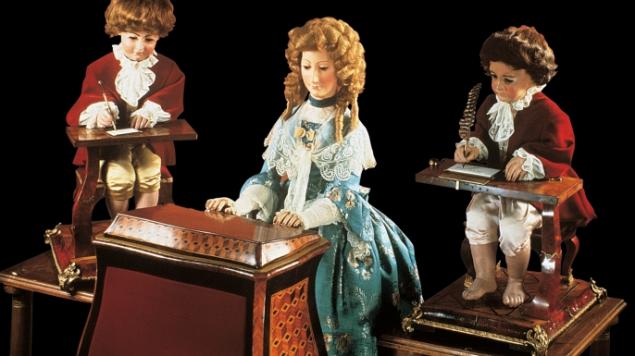
Automatons are mechanisms. Stories about humanoid robots walked in Ancient Greece, for example, the moving statues. But it is much more real doesn't look very complex mechanism, which is described by Philo Byzantine, who died in 220 BC. In the book "Pneumatics" he described the device in the form of a woman who in one hand holds a pitcher of wine, and the team with the installation of the glass in the other hand, she poured the wine and added water into it. But who needs robots if there are slaves?
Leonardo Da Vinci, the greatest artist, scientist, musician and inventor, in the XV century, developed the technology of humanoid mechanism. It was the first in the history of Android. Before you create it, Da Vinci spent a lot of time in the anatomical school, slitting the dead and learning the secrets of the human body.
The mechanism was inside the knight's armor. Knight may have been able to walk, stand and sit, move your arms and neck. Unfortunately, the video did not take off.
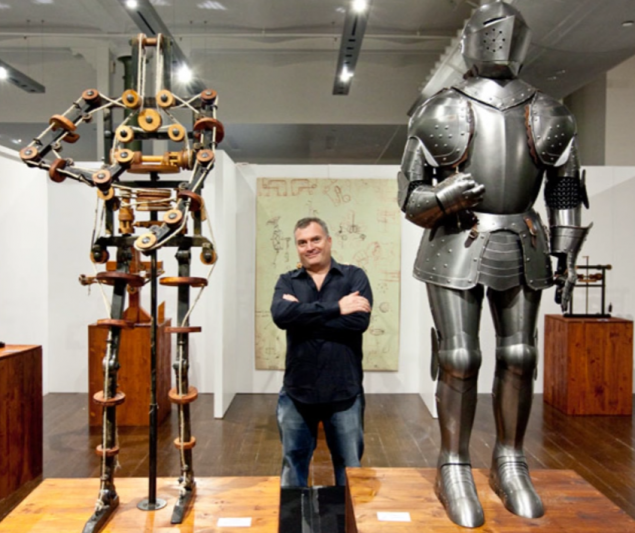
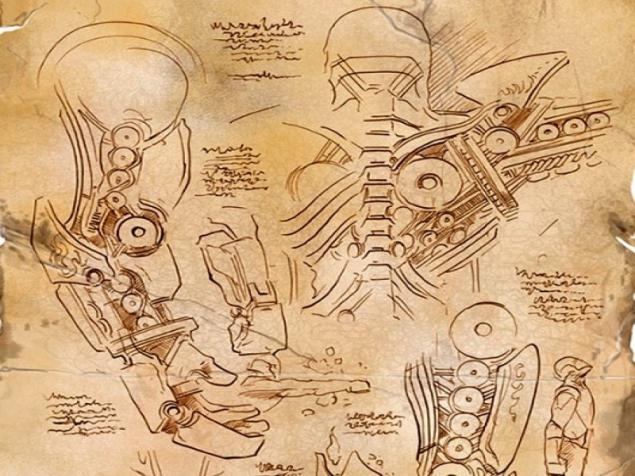
Sketch — imagination of our contemporary artist
King Philip II of Spain in 1560 ordered the engineer Juanelo, Torriano to create a mechanical monk. The monk could be baptized, to raise the crucifixion, to move the lips as if he was praying for the king. The figure moved on wheels, but she was realistic and feet that are visible from under his robe.
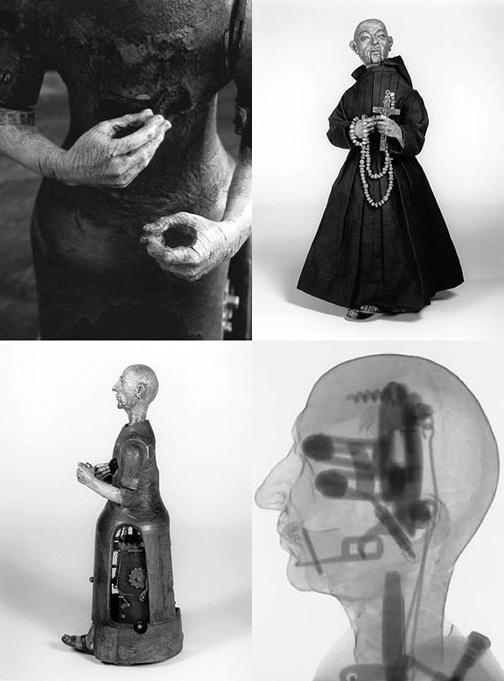
In 1737 French inventor Jacques de Vaucanson built the flute player, the repertoire of which consisted of twelve musical compositions, as well as a musician with a tambourine.
Lungs like bellows. Vaucanson also likes working with corpses, imitated their work. He had to learn the game of a living person. Air movement was controlled by the tongue, lips, opened, closed and moved, the air came with a mechanical lung — bellows.
The holes on the flute clamped in the desired sequence of mechanical fingers. As the wooden fingers could not fit snugly to the flute, the master used real human skin.


Later, Vaucanson designed and assembled from four parts, the duck, who was flapping its wings, eat, digest grain and then defecated. According to the author, the duck had actually digest food through chemical reactions in a separate tank, but this is, unfortunately, not reached. Instead, the grain in one compartment and a pre-prepared excrement out of the other. Duck became the most famous of his creation. All three of the automaton included in one collection and made submissions to the public.
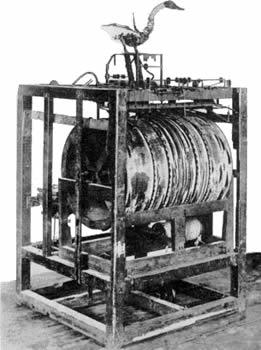

The most important item for the construction of automatons was the eccentric disk or the sector disk mounted on a rotating shaft so that its axis does not coincide with the axis of rotation of the shaft. Thus the rotational movement is translational.
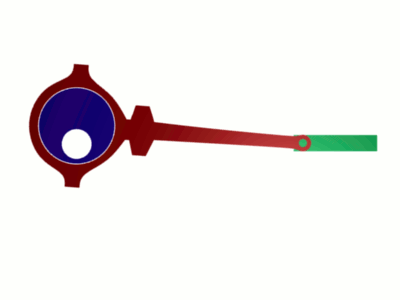
Of course, where would we be without the Japanese, when it comes to fine work. The doll in the video below is set in motion by a string which she tied to a mechanism similar time. Eccentric pull strings and let them go, causing the doll to take different actions.
It's not just moving hands. She takes an arrow, pulls the bowstring and release it. Then takes the new arrow off the platform during the shot changed position. The Archer manages to artistically move my head.
In 1740-ies of Archbishop Jacob von Ditrichstein (Jakob von Dietrichstein) built an automaton that represents the theatre of the two hundred figures at one stage running concurrently. So he depicted the life of the ideal city. We see how close the Coopers barrel hammer hammer bull, builders raised plaque on the building, and the top over the hard work of ordinary people watching the aristocracy.
The water in the mechanism rotates the wheel through multiple gear transmits the rotation of the drum. The drum contains instructions for each character.
Automatons are closely associated with the art of making watches. As you can see, almost always the masters of this region have developed a moving puppet. In the world built many tower clocks with figures who commit actions. For example, it is Prague astronomical clock. They installed in 1410 and is the oldest working astronomical clock. In the XVII century they added the moving figure of death-a skeleton with a bell and screaming the Golden rooster.
Perhaps the most famous automaton in Russia — it is a watch with a peacock on display in the Hermitage in St. Petersburg. The clock was made in Britain in the 1770-ies. Every Wednesday, head of the Laboratory clocks and musical mechanisms of the State Hermitage Mikhail Guryev leads them, after which hours work for eight hours.
Catherine spent hours of 11 000 rubles in 1781. During transportation from London mechanism damaged, but came to the aid of Ivan Kulibin — he had to collect the clock, pulling parts from piles in baskets.
The composition involved several birds. Owl in the cage rotates with the eyes, moves her head to the beat of the bells dance of the foot. The peacock bows and spreads its tail. Then the rooster raises his head and hear a resounding "cock a Doodle Doo".
Peacock was created by a London jeweler and inventor James Cox. Another interesting work was a silver Swan with a long flexible neck, looking for food in the silver pond with fish. It works 40 seconds on a single plant, but it looks almost like alive. During operation, it catches the fish and eats it. Even the water seems real — it is made of rotating glass cylinders with notches of different shapes.
In the eighteenth and nineteenth century, automatons were the entertainment of the wealthiest segments of society. But did these works of art are much more poor people: artisans, produce components, and watchmakers, gathering them together. To earn more money, have more mechanisms, and possibly to reduce the price. Already three hundred years ago began the trend in the miniaturization of devices. And hours became less, and automatons were reduced in size.
Timepieces that 500 years ago took place in the towers, decreased to the size that allows you to place them highly complicated version in the body of the doll. And then in a device the size of a box.
An example of a miniature automaton — this bird in a cage, made in the 1860's.
Another great example is jewelry Easter egg "Bay tree", made by the firm of Carl Faberge in 1911 by the order of Nicholas II. He gave him to his mother Maria Feodorovna. After winding the cover eggs in the tree opens and a bird appears. She turns and sings.
By the way, the company Jaquet Droz is now in assortment there are watches with automaton. This watch with songbird are 380 000 Swiss francs, is 25 million rubles.
In 1784 was assembled by an automaton made in the image of the Queen of France Marie-Antoinette. The doll rotates eyes, looks around, moves his head, breathes and plays a musical instrument.
But Marie-Antoinette in a negligee. We see a drum with notches, which pulls the strings for each action in sequence.
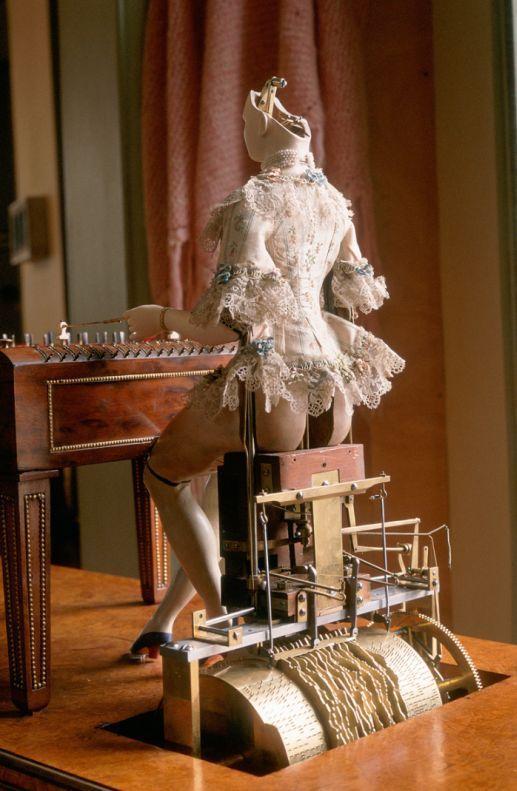
Automatons not only played instruments, but was able to write with a pen on paper. Of course, strictly certain things, to reprogram a doll was difficult (although there are exceptions). In the video below — the work of 1773.
"The artist" masters of Jaquet Droz consists of 2,000 items. He is able to draw three pictures: a portrait of Louis XV and his dog, signed, Marie Antoinette to Louis XVI and Cupid, managing a chariot with butterflies. The most plausible mechanism is given by its unauthorized actions — he fidgets in his chair, shakes his head and blows away the dust. It is difficult to imagine the amazement with which at the time could meet this robot.
A much more complex mechanism Jaquet Droz is called "Calligrapher". The device is assembled from 6 000 details. The whole mechanism placed in the body of the doll. Pen on paper, the boy carefully removes the text. After each letter the second hand it moves a sheet of paper to begin the next character shakes up the pen, dips it in the inkwell.
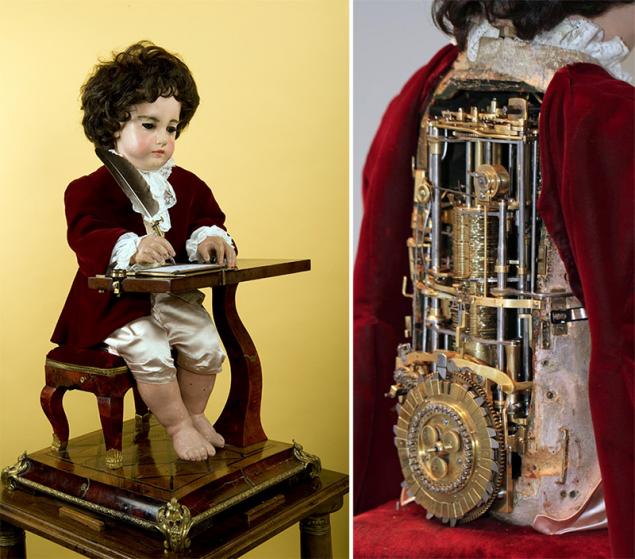
Characters that boy prints on paper, encoded on a round plate in the mechanism. This is more like an automaton on automatic printing machine or a printer. What is surprising is that the master has provided the ability to change the text. The disk is rotated, and character information is transmitted sequentially to the machine. The letters on the disk can be replaced, instead of the characters may be exhibited in the blanks.
Inside the doll was a stack of eccentrics that make the transmitted drive signal into movement of the hands.
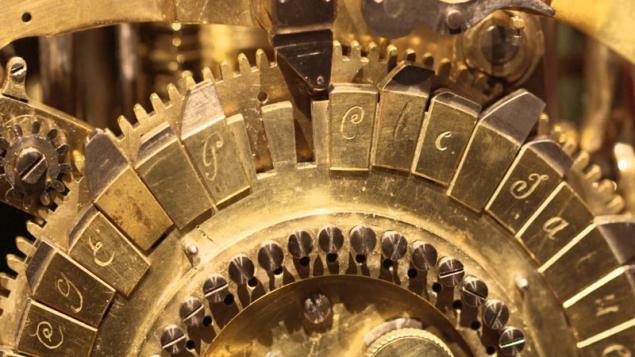

The Swiss watch brand created by Pierre Jaquet-Droz, still exists, and makes to order, these automatons. Production takes a year.
In 1810 the English master of Swiss origin Henry Maillardet built the draughtsman-writer. He wrote poems in three languages and beautifully designed as well as painted image of Cupid in the garden or in a chariot, ship, Chinese temple.
The result was these pictures:

Gaston Descamps in 1907 he collected an automaton "Zulma — snake-Charmer". Here we see a girl, eye-opening, breathing and turning the neck and moving the snake. All this accompanied by music.
The automatons you can make, not only with their sales, but also through the mass deception of people. It will now go about the chess player-the Turk, one of the interpretations of which in 1804 defeated Napoleon.
Hungarian inventor Farkas Kempelen collected full-size figure of a man sitting at a chess table. At the beginning of the presentation, people were shown a mechanism inside the Desk and empty shelves, illuminating the inside of the table candle. Then the door closed and started the game.
Inside was hidden workplace of the living chess player. The main advantage of the automaton is that inside man is ruled by the hand of a Turk, and not just moved it, and grabbed the figure and rearranged it, and understand where and what the figure is due to the magnets in the bottom of the main chessboard. This is a great example of the early manipulator.
The party against Napoleon defeated the Turks. Then the table sat Johann Allgeier, the strongest Austrian player of the early XIX century.
If to speak simply, almost all of the automatons was a wind-up mechanisms, such as the clock, in any way connected with the doll or other figure and forcing her to move. The most amazing of them seem Calligrapher, due to the fact that the master had originally provided for the possibility of reprogramming mechanism and the silver Swan because of the realism. But for ordinary people, absolutely everything working automatons could seem like a miracle.
Source: geektimes.ru/post/282452/
But as it looked a couple hundred years ago? Or four hundred years? Yes, there was also some similarity robots, a mechanical device resembling a human or animal. They played musical instruments, wrote with a pen, danced, growled, and made other actions capable of shocking the common man. Today we are talking about mechanical monks, egg-laying ducks and programmable writing boys.

Automatons are mechanisms. Stories about humanoid robots walked in Ancient Greece, for example, the moving statues. But it is much more real doesn't look very complex mechanism, which is described by Philo Byzantine, who died in 220 BC. In the book "Pneumatics" he described the device in the form of a woman who in one hand holds a pitcher of wine, and the team with the installation of the glass in the other hand, she poured the wine and added water into it. But who needs robots if there are slaves?
Leonardo Da Vinci, the greatest artist, scientist, musician and inventor, in the XV century, developed the technology of humanoid mechanism. It was the first in the history of Android. Before you create it, Da Vinci spent a lot of time in the anatomical school, slitting the dead and learning the secrets of the human body.
The mechanism was inside the knight's armor. Knight may have been able to walk, stand and sit, move your arms and neck. Unfortunately, the video did not take off.


Sketch — imagination of our contemporary artist
King Philip II of Spain in 1560 ordered the engineer Juanelo, Torriano to create a mechanical monk. The monk could be baptized, to raise the crucifixion, to move the lips as if he was praying for the king. The figure moved on wheels, but she was realistic and feet that are visible from under his robe.

In 1737 French inventor Jacques de Vaucanson built the flute player, the repertoire of which consisted of twelve musical compositions, as well as a musician with a tambourine.
Lungs like bellows. Vaucanson also likes working with corpses, imitated their work. He had to learn the game of a living person. Air movement was controlled by the tongue, lips, opened, closed and moved, the air came with a mechanical lung — bellows.
The holes on the flute clamped in the desired sequence of mechanical fingers. As the wooden fingers could not fit snugly to the flute, the master used real human skin.


Later, Vaucanson designed and assembled from four parts, the duck, who was flapping its wings, eat, digest grain and then defecated. According to the author, the duck had actually digest food through chemical reactions in a separate tank, but this is, unfortunately, not reached. Instead, the grain in one compartment and a pre-prepared excrement out of the other. Duck became the most famous of his creation. All three of the automaton included in one collection and made submissions to the public.


The most important item for the construction of automatons was the eccentric disk or the sector disk mounted on a rotating shaft so that its axis does not coincide with the axis of rotation of the shaft. Thus the rotational movement is translational.

Of course, where would we be without the Japanese, when it comes to fine work. The doll in the video below is set in motion by a string which she tied to a mechanism similar time. Eccentric pull strings and let them go, causing the doll to take different actions.
It's not just moving hands. She takes an arrow, pulls the bowstring and release it. Then takes the new arrow off the platform during the shot changed position. The Archer manages to artistically move my head.
In 1740-ies of Archbishop Jacob von Ditrichstein (Jakob von Dietrichstein) built an automaton that represents the theatre of the two hundred figures at one stage running concurrently. So he depicted the life of the ideal city. We see how close the Coopers barrel hammer hammer bull, builders raised plaque on the building, and the top over the hard work of ordinary people watching the aristocracy.
The water in the mechanism rotates the wheel through multiple gear transmits the rotation of the drum. The drum contains instructions for each character.
Automatons are closely associated with the art of making watches. As you can see, almost always the masters of this region have developed a moving puppet. In the world built many tower clocks with figures who commit actions. For example, it is Prague astronomical clock. They installed in 1410 and is the oldest working astronomical clock. In the XVII century they added the moving figure of death-a skeleton with a bell and screaming the Golden rooster.
Perhaps the most famous automaton in Russia — it is a watch with a peacock on display in the Hermitage in St. Petersburg. The clock was made in Britain in the 1770-ies. Every Wednesday, head of the Laboratory clocks and musical mechanisms of the State Hermitage Mikhail Guryev leads them, after which hours work for eight hours.
Catherine spent hours of 11 000 rubles in 1781. During transportation from London mechanism damaged, but came to the aid of Ivan Kulibin — he had to collect the clock, pulling parts from piles in baskets.
The composition involved several birds. Owl in the cage rotates with the eyes, moves her head to the beat of the bells dance of the foot. The peacock bows and spreads its tail. Then the rooster raises his head and hear a resounding "cock a Doodle Doo".
Peacock was created by a London jeweler and inventor James Cox. Another interesting work was a silver Swan with a long flexible neck, looking for food in the silver pond with fish. It works 40 seconds on a single plant, but it looks almost like alive. During operation, it catches the fish and eats it. Even the water seems real — it is made of rotating glass cylinders with notches of different shapes.
In the eighteenth and nineteenth century, automatons were the entertainment of the wealthiest segments of society. But did these works of art are much more poor people: artisans, produce components, and watchmakers, gathering them together. To earn more money, have more mechanisms, and possibly to reduce the price. Already three hundred years ago began the trend in the miniaturization of devices. And hours became less, and automatons were reduced in size.
Timepieces that 500 years ago took place in the towers, decreased to the size that allows you to place them highly complicated version in the body of the doll. And then in a device the size of a box.
An example of a miniature automaton — this bird in a cage, made in the 1860's.
Another great example is jewelry Easter egg "Bay tree", made by the firm of Carl Faberge in 1911 by the order of Nicholas II. He gave him to his mother Maria Feodorovna. After winding the cover eggs in the tree opens and a bird appears. She turns and sings.
By the way, the company Jaquet Droz is now in assortment there are watches with automaton. This watch with songbird are 380 000 Swiss francs, is 25 million rubles.
In 1784 was assembled by an automaton made in the image of the Queen of France Marie-Antoinette. The doll rotates eyes, looks around, moves his head, breathes and plays a musical instrument.
But Marie-Antoinette in a negligee. We see a drum with notches, which pulls the strings for each action in sequence.

Automatons not only played instruments, but was able to write with a pen on paper. Of course, strictly certain things, to reprogram a doll was difficult (although there are exceptions). In the video below — the work of 1773.
"The artist" masters of Jaquet Droz consists of 2,000 items. He is able to draw three pictures: a portrait of Louis XV and his dog, signed, Marie Antoinette to Louis XVI and Cupid, managing a chariot with butterflies. The most plausible mechanism is given by its unauthorized actions — he fidgets in his chair, shakes his head and blows away the dust. It is difficult to imagine the amazement with which at the time could meet this robot.
A much more complex mechanism Jaquet Droz is called "Calligrapher". The device is assembled from 6 000 details. The whole mechanism placed in the body of the doll. Pen on paper, the boy carefully removes the text. After each letter the second hand it moves a sheet of paper to begin the next character shakes up the pen, dips it in the inkwell.

Characters that boy prints on paper, encoded on a round plate in the mechanism. This is more like an automaton on automatic printing machine or a printer. What is surprising is that the master has provided the ability to change the text. The disk is rotated, and character information is transmitted sequentially to the machine. The letters on the disk can be replaced, instead of the characters may be exhibited in the blanks.
Inside the doll was a stack of eccentrics that make the transmitted drive signal into movement of the hands.


The Swiss watch brand created by Pierre Jaquet-Droz, still exists, and makes to order, these automatons. Production takes a year.
In 1810 the English master of Swiss origin Henry Maillardet built the draughtsman-writer. He wrote poems in three languages and beautifully designed as well as painted image of Cupid in the garden or in a chariot, ship, Chinese temple.
The result was these pictures:

Gaston Descamps in 1907 he collected an automaton "Zulma — snake-Charmer". Here we see a girl, eye-opening, breathing and turning the neck and moving the snake. All this accompanied by music.
The automatons you can make, not only with their sales, but also through the mass deception of people. It will now go about the chess player-the Turk, one of the interpretations of which in 1804 defeated Napoleon.
Hungarian inventor Farkas Kempelen collected full-size figure of a man sitting at a chess table. At the beginning of the presentation, people were shown a mechanism inside the Desk and empty shelves, illuminating the inside of the table candle. Then the door closed and started the game.
Inside was hidden workplace of the living chess player. The main advantage of the automaton is that inside man is ruled by the hand of a Turk, and not just moved it, and grabbed the figure and rearranged it, and understand where and what the figure is due to the magnets in the bottom of the main chessboard. This is a great example of the early manipulator.
The party against Napoleon defeated the Turks. Then the table sat Johann Allgeier, the strongest Austrian player of the early XIX century.
If to speak simply, almost all of the automatons was a wind-up mechanisms, such as the clock, in any way connected with the doll or other figure and forcing her to move. The most amazing of them seem Calligrapher, due to the fact that the master had originally provided for the possibility of reprogramming mechanism and the silver Swan because of the realism. But for ordinary people, absolutely everything working automatons could seem like a miracle.
Source: geektimes.ru/post/282452/





